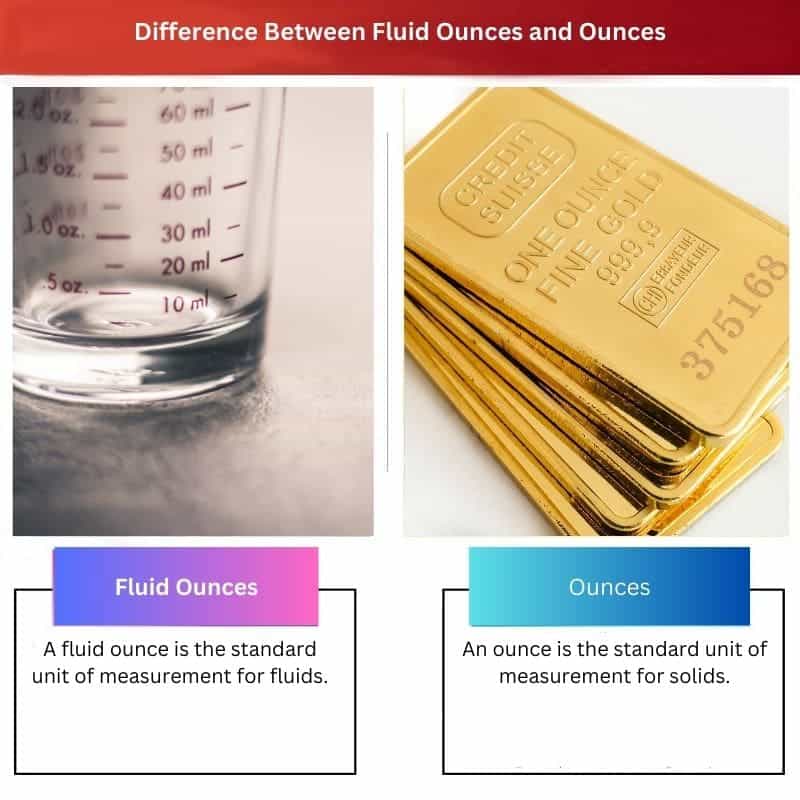A unit of measurement is the standard magnitude of a quantity used to measure the multiples of this quantity. Fluid ounces and ounces are two such units.
Key Takeaways
- Measurement: Fluid ounces measure volume, while ounces measure weight.
- Unit conversion: Fluid ounces are part of the imperial system and are approximately 29.57 milliliters, whereas ounces are approximately 28.35 grams.
- Application: Fluid ounces are used for liquids like beverages or oils, while ounces are used for solids like food or small objects.
Fluid Ounces vs Ounces
The difference between a fluid ounce and an ounce is that a fluid ounce measures fluids and their volumetric properties, whereas an ounce measures the mass and weight of solid materials.

A fluid ounce is a standard unit for measuring the capacity of a liquid. This capacity is volume. It is widely used in the USA and other western countries to count the number of drinks.
An ounce is a standard unit for the primary measurement of the mass of a physical quantity. It is further subdivided into many categories for different types of materials.
Comparison Table
| Parameter Of Comparison | Fluid Ounces | Ounces |
|---|---|---|
| Definition | A fluid ounce is the standard unit of measurement for fluids. | An ounce is the standard unit of measurement for solids. |
| Representation | It is represented by the abbreviation fl oz. | It is represented by the abbreviation oz. |
| Parameter Measured | Fluid ounces measure the volume of a liquid. | Ounces measure the weight or mass of a solid. |
| Type of Measurement | It is a fluid measurement. | It is a dry measurement. |
| Utility | It is commonly used to measure the number of wines, beverages, and other liquids. | It is commonly used to measure the weight of packages, fabric, and paper. |
What are Fluid Ounces?
A fluid ounce is mainly used to measure the volume of fluids. The abbreviation that represents it is fl oz. There are many types of fluid ounces used, namely troy and avoirdupois.
There are two measurement standards for fluid ounces today. One is the imperial fluid ounce, and the other is the US customary fluid ounce. An imperial fluid ounce is equivalent to 1/160th of an imperial gallon.
A US customary fluid ounce is equivalent to 1/128th of a US gallon. It equals 1/32th of a US quart and 1/8th of a US cup.

What are Ounces?
An ounce is mainly used to measure the mass or weight of solids. The abbreviation that represents it is oz. The word ounce has been derived from the Latin word uncia.
There are many measurement standards used by different countries for ounces today. These are the International avoirdupois ounce, International troy ounce, and metric ounce.
The International troy ounce measures the mass of metals such as gold and silver. It is equal to 480 grains or 31.10 grams.

Main Differences Between Fluid Ounces and Ounces
Ounces are a standard unit of measurement in the Western world. Fluid ounces are a subcategory of ounces. The common term ounce is used to address both of these units.
The main differences between the two are :
- A fluid ounce is used to measure fluids, whereas an ounce is used to measure a solid substance.
- A fluid ounce is represented by fl oz, whereas an ounce is by oz.
Comparing Fluid Ounces and Regular Ounces
As you explore the world of measurements, it’s essential to understand the difference between fluid ounces and regular ounces. These two units of measurement may seem similar, but they serve distinct purposes and cannot be used interchangeably.
Fluid ounces primarily measure the volume of liquids. For example, you’ll likely use fluid ounces when measuring ingredients for a recipe, such as water, milk, or oil. This unit is denoted as “fl oz” and is a standard measure of liquid capacity, particularly in the United States.
Regular ounces, on the other hand, are utilized for measuring the weight or mass of solid materials. This unit is represented by the symbol “oz” and is commonly used for cooking items like produce, packaged goods, and ingredients such as flour or sugar.
One key point is that the relationship between fluid ounces and regular ounces is not a direct conversion. Since a fluid ounce measures volume and a regular ounce measures mass or weight, comparing these units depends on the specific substance. For example, one fluid ounce of water weighs approximately one regular ounce, but this correspondence does not hold true for other substances with different densities.
When working with recipes and cooking instructions, it’s imperative to use the correct unit of measurement, as this can greatly impact the quality of your end result. Utilizing a kitchen scale and liquid measuring cups can help ensure accuracy and prevent mix-ups between fluid and regular ounces.
In summary, while fluid ounces and regular ounces may appear similar at first glance, they serve very different purposes in measurement. Fluid ounces measure liquid volume, while regular ounces measure the weight or mass of solid materials. Being mindful of these distinctions will aid you in navigating recipes and other situations requiring precise measurement.
Practical Uses of Fluid Ounces vs Regular Ounces
When dealing with various substances, it is essential to differentiate between fluid ounces and regular ounces. Fluid ounces (fl oz) measure the volume of a liquid, while regular ounces (oz) measure the weight of a solid.
You’ll encounter both fluid and regular ounces in recipes as you cook. For instance, you would use fluid ounces when measuring ingredients such as milk, oil, or salad dressing. On the other hand, you’ll use regular ounces to weigh ingredients like flour, sugar, or butter. Understanding the difference between these two units can greatly improve the accuracy of your recipes and cooking methods.
In daily life, you may come across items packaged in fluid ounces, especially beverages. For example, a standard can of soda holds 12 fluid ounces. Being familiar with this unit helps you be more aware of the volume of liquids you consume.
Remember that a substance’s weight and volume do not always correspond, as various materials have different densities. An important consideration for determining the weight or volume of an ingredient is to check for any markings that indicate whether it is measured in fluid ounces or regular ounces. Remember:
- Use fluid ounces when measuring the volume of liquids.
- Use regular ounces when measuring the weight of solid substances.
You can ensure precision in your cooking, shopping, and daily life by correctly applying these measurement units.
Unit Conversion: Regular Ounces to Fluid Ounces
Converting regular ounces (weight) to fluid ounces (volume) can be tricky, as they measure different properties–weight and volume, respectively. However, performing unit conversions for certain substances with known densities is possible. This section will discuss two methods to convert ounces to fluid ounces: using a conversion table and applying conversion formulas.
Using a Conversion Table
A conversion table can conveniently and quickly convert between regular and fluid ounces for specific substances. To use a table, you look up the substance you are working with and find the equivalent value in fluid ounces for the given weight in regular ounces. Remember that conversion tables only work for specific substances with known densities.
For example:
| Substance | Density (g/mL) | Ounces to Fluid Ounces Conversion Factor |
|---|---|---|
| Water | 1.00 | 1.043 |
| Milk | 1.03 | 1.075 |
| Olive oil | 0.92 | 0.965 |
To convert an amount in regular ounces to fluid ounces, multiply the regular ounces value by the conversion factor from the table.
Applying Conversion Formulas
For substances with known densities, you can apply conversion formulas to determine the equivalent fluid ounces for a given weight in regular ounces.
- Determine the density (ρ) of the substance in grams per milliliter (g/mL) or look it up in a trusted source if available.
- Convert the weight in regular ounces (oz) to grams (g) using the following formula:
Weight (g) = Weight (oz) × 28.35 - Calculate the volume in milliliters (mL) using the density:
Volume (mL) = Weight (g) ÷ Density (ρ, g/mL) - Finally, convert the volume (mL) to fluid ounces (fl oz) with:
Volume (fl oz) = Volume (mL) × 0.034
With these formulas, you can convert between regular ounces and fluid ounces for any substance with a known density. Remember that the conversion factor will vary depending on the substance’s properties.
Impact of Fluid Ounces vs Regular Ounces in Daily Life
In your daily life, understanding the difference between fluid ounces and regular ounces (weight) is crucial in various activities, such as cooking, baking, and even shopping. While fluid ounces (fl. oz.) measure the volume or capacity of liquids, regular ounces (oz.) tackle the weight or mass of solids.
Imagine preparing a recipe that calls for liquid and solid ingredients. If you incorrectly utilize the unit measurements, it could lead to inconsistencies in your final product. For instance, 1 cup of white sugar weighs 7.1 ounces, while 1 cup of milk weights 8.6 ounces. Using fluid ounces for sugar or regular ounces for milk would impact the intended results of the recipe.
Furthermore, when shopping for products consisting of liquid and solid elements, the distinction between fluid ounces and regular ounces is crucial for accurate comparisons and evaluations. Many products showcase their contents in fl. oz., while others might use oz. Or even grams and millilitres. Without a thorough understanding of these measurement variations, comparing products and selecting the most appropriate one for your needs can be challenging.
Another essential aspect of distinguishing fluid ounces from regular ounces is personal health. Keeping track of your daily water intake is vital for overall well-being, and confusion between the two measurements could lead to improper hydration levels. For example, the Mayo Clinic states that daily water intake recommendations vary, but knowing that fluid ounces specifically measure liquid volume can guide you in developing personalized hydration strategies.


The article was quite intriguing. The explanations provided were engaging and informative.
I second your opinion. The article is engaging and informative.
I couldn’t agree more. The article does a fantastic job of presenting the information effectively.
An enlightening read that enhances comprehension of fluid ounces and ounces. A well-written article indeed.
I concur. The article is an excellent source of information and clarification on the topic.
I think the article is overly detailed and complex for the average reader. It would benefit from a simplified explanation.
I disagree, I believe the complexity is necessary to truly comprehend the topic.
I’m inclined to agree with Sholmes. The article could be more reader-friendly with a less technical approach.
The article does a commendable job of explaining the differences between fluid ounces and ounces in a straightforward manner.
Absolutely. It provides a clear understanding of a somewhat challenging topic.
I found the article to be a great source of knowledge and clarity.
The article is as clear as mud. It makes a simple topic unnecessarily convoluted.
I understand where you’re coming from, but complexity is sometimes inevitable when discussing intricate concepts.
Very well-written article. I appreciate the insights and detailed comparisons between fluid ounces and ounces.
An interesting read that provides a comprehensive understanding of fluid ounces and regular ounces. I feel more educated on this topic now.
I concur with your sentiment. This article is indeed an excellent resource for gaining knowledge about fluid ounces and ounces.
I appreciate the intricate details provided in the article; it’s a great reference for anyone seeking to understand the concepts better.
This article simplifies the complexities of fluid ounces and ounces, making it easier to comprehend.
Indeed, the article excels in presenting complex information in a reader-friendly manner.
The detailed comparison between fluid ounces and ounces in the article is invaluable. It’s an excellent reference.
Definitely. The article offers a comprehensive and detailed analysis of fluid ounces and ounces.
I couldn’t agree more. This article provides an exceptional breakdown of the differences.
A very informative and well-explained article. The differences between fluid ounces and ounces are now very clear to me.
I agree, fluid ounces and ounces are confused, but this article resolves all the ambiguities.
I found this article enlightening as it clearly explains the distinctions between fluid ounces and ounces.